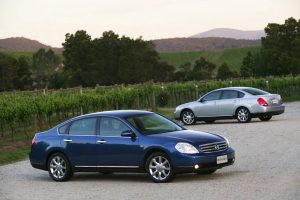Recalls: Nissan J31 Maxima
Overview
Manufacturers, or importers, issue recalls for defects or faults which have the potential to cause injury. Generally, manufacturers will inform the original buyers if their vehicle is subject to a recall and of the steps required to remedy the defect or fault. Please note that the recalls below (if any) are for Australian-delivered vehicles only. Furthermore, the number of recalls should not be taken as an indication of a model’s reliability or its safety more generally.
Recalls: Nissan J31 Maxima
2003-08 Nissan J31 Maxima V6: air intake duct may disconnect
In June 2009, recalls were issued for Nissan J31 Maxima vehicles that had 3.5-litre VQ35 engines and were manufactured between August 2003 and January 2008. In these vehicles, the engine air intake duct may become disconnected due to the combination of thermal loading and normal engine vibrations. If this occurred, the engine may exhibit rough idling and, at worst, may stall. The recalled vehicles had VINs in the range JN1BBUJ31A0 000014 to JN1BBUJ3A0 302117 (PRA 2009/10860, PRA 2009/10877, R0902).
2003 Nissan J31 Maxima: Takata airbag recall
In June 2015, a recall was issued for Nissan J31 Maxima vehicles that were manufactured between April 2003 and December 2003 – this recall was an amendment to previous recalls that were issued in 2013 and 2014. In these vehicles, the front passenger air bag inflator may have been assembled with improperly manufactured propellant wafers. In the event of a collision, the combustion rate of the propellant may increase inside the inflator, causing internal pressure to rise suddenly during airbag deployment. Such deployment could cause the inflator housing to rupture and disperse metal fragments, increasing the risk of injury to the occupant. The recalled Nissan J31 Maxima vehicles had VINs in the range JN1BBUJ31A0000014 to JN1BBUJ31A0002114 (PRA 2015/14751).
2004-07 Nissan J31 Maxima: Takata airbag recall
In June 2015, a recall was issued for Nissan J31 Maxima vehicles that were manufactured between January 2004 and March 2007. In these vehicles, the front passenger air bag inflator may have been assembled with improperly manufactured propellant wafers. In the event of a collision, the combustion rate of the propellant may increase inside the inflator, causing internal pressure to rise suddenly during airbag deployment. Such deployment could cause the inflator housing to rupture and disperse metal fragments, increasing the risk of injury to the occupant. The recalled Nissan J31 Maxima vehicles had VINs in the range JN1BBUJ31A0002121 to JN1BBUJ31A0300471 (PRA 2015/14752).
Nissan J31 Maxima: Takata airbag recall
In July 2015, Nissan extended its recall of Nissan J31 Maxima vehicles with front passenger airbags for the same defect as described in the recall above. Although the recall notice did not provide the dates of manufacture or VINs of these additional vehicles, it is understood that the recalled vehicles were manufactured from April 2007 to December 2008 (PRA 2015/14821).
2003-08 Nissan J31 Maxima: Takata airbag recall (‘like for like’ replacement)
In November 2018, recall campaign R1803 was issued for 2003-08 production year Nissan J31 Maxima vehicles. This recall was issued for vehicles that had already had their Takata passenger airbag inflator replaced with a Takata airbag inflator of the same type (i.e. ‘like for like’ replacement) under a previous recall. For this recall, however, the airbag inflator was to be replaced with one that did not have the same defect as the original and its ‘like for like’ replacement whereby the airbag inflator propellant could degrade over time such that excessive pressure on deployment could cause the metal inflator housing to rupture and project metal fragments into the cabin. For the VINs of the recalled vehicles, please see PRA 2018/17163.
Search online for recalls by VIN
To see if a Nissan vehicle has been recalled due to the fitment of Takata airbags, you can conduct a search on the Nissan Australia website using its VIN.
Problems and faults: Nissan J31 Maxima
Overview
This section identifies potential problems, causes and fixes based on the experiences of owners and repairers, online sources and technical service bulletins. This information is provided solely for reference purposes and AustralianCar.Reviews recommends that only properly qualified persons carry out repairs or modifications. Furthermore, the number of items below should not be taken as an indicator of a model’s reliability or the frequency with which they may occur.
To report a problem or fault to the AustralianCar.Reviews team, please use the Contact Us form. Note that AustralianCar.Reviews does not offer advice on automotive problems or disputes; such enquiries will not receive a reply. For vehicles purchased from dealers after 1 January 2011, please see our Australian Consumer Law fact sheet.
Problems and faults: Nissan J31 Maxima
- The Maxima’s front engine mount is susceptible to wear and is affected by driving style.
- The high pressure power steering hose may fail, causing power steering fluid to leak and the steering to become heavier (particularly during low speed manoeuvres).
- When the anti-lock braking system (ABS) engages, it may make chattering or clicking noises and be accompanied by vibrations through the brake pedal – this is normal. Furthermore, the ABS will conduct a self-test after starting the vehicle and reaching about 15 km/h.
- Up to 1 litre of engine oil consumption per 10,000km is considered acceptable; anything more should be investigated.




